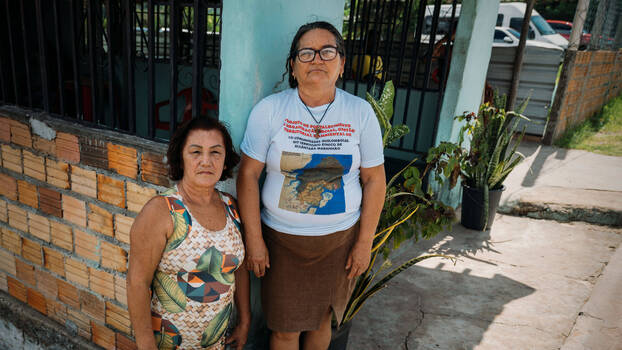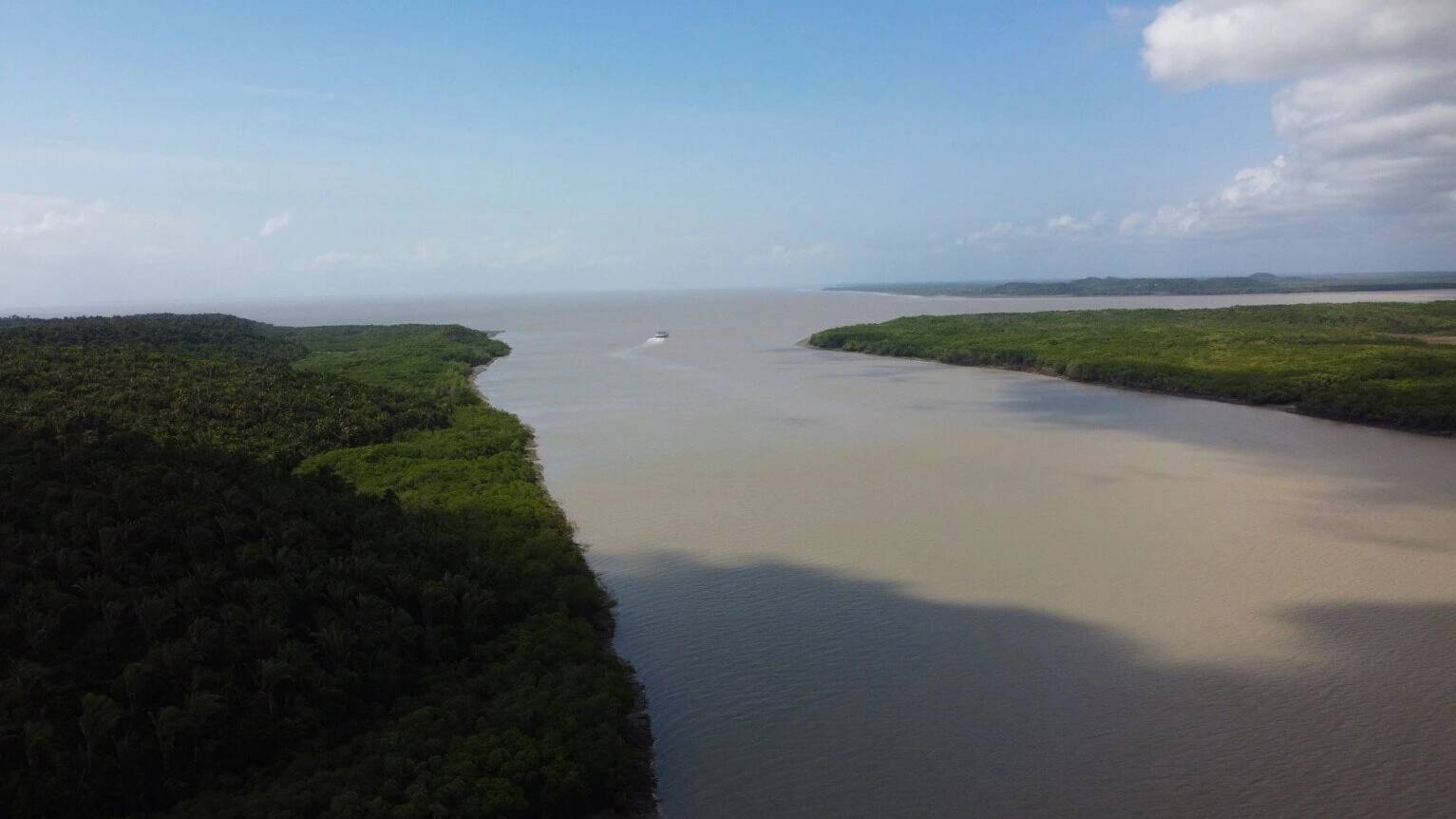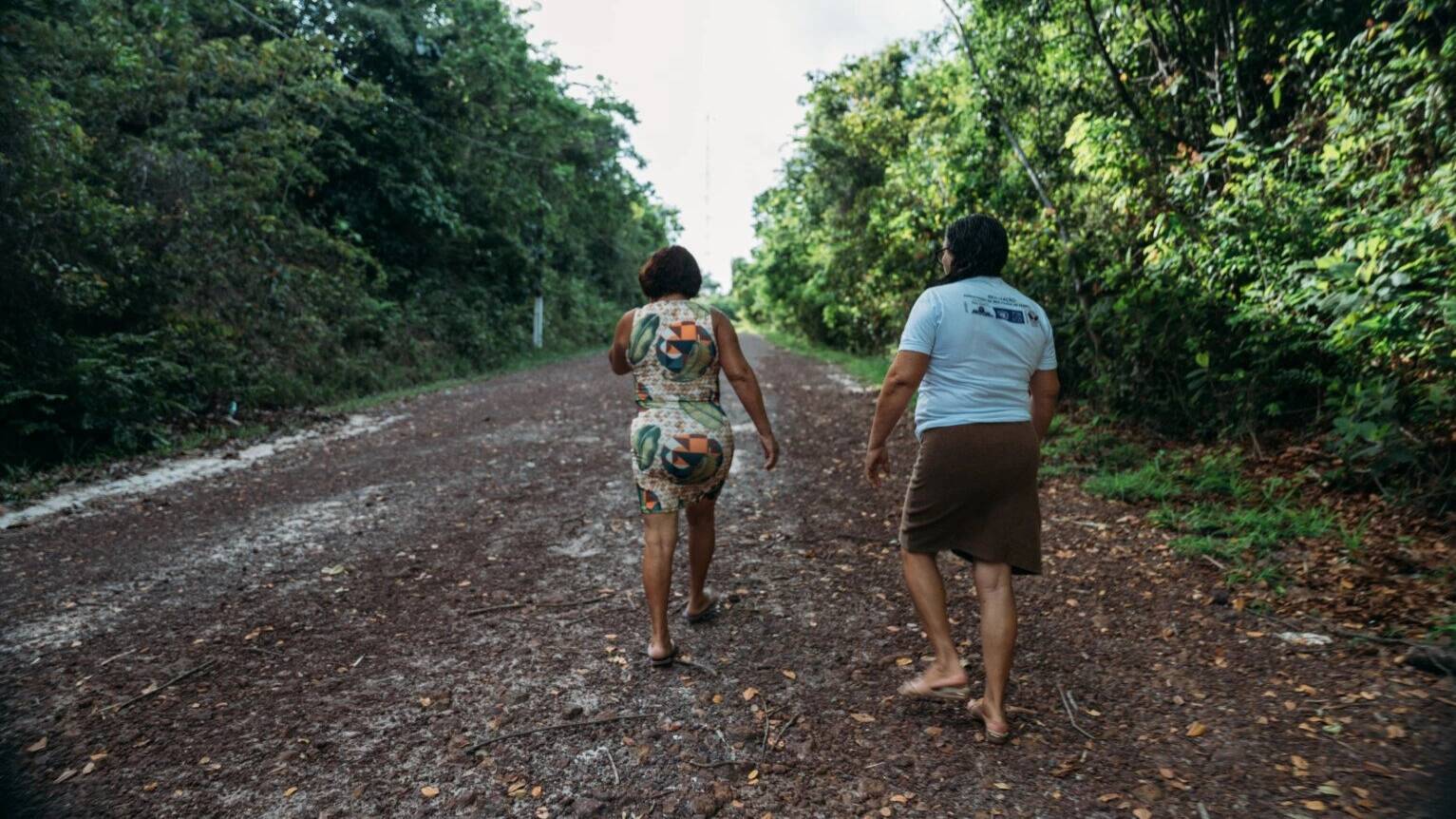
Changes are coming to the landscape of Cajual Island, in Brazil’s northeastern state of Maranhão. Its leafy forests and babassu coconut palm groves will be replaced by up to 350-metre-long cargo ships carrying thousands of tons of iron, copper, soya beans, corn, and other commodities to China, the United States, and Europe.
Felipe Sabrina is a Brazilian journalist who writes about human rights, access to land and territory.
By 2027, the island’s multi-kilometre-long beaches and mangroves will give way to a port complex, with railway lines, power substations, and warehouses, where 1,800 workers will take turns day and night on the island of the municipality of Alcântara.
This is the change that the Portuguese-born, naturalized Brazilian executives Paulo Salvador, Nuno da Mota e Silva, and Nuno Martins of the Grão-Pará Maranhão corporation (GPM) plan to produce. Their idea is to have nearly 90 percent of the Vila Nova Quilombola Territory, on Cajual Island, occupied by the Alcântara Port Terminal and the EF-317 Railway.
“An enterprise of this scale effectively extinguishes the local Quilombola territory. It makes the protection of the territory completely impossible”, Yuri Costa, a federal public defender in Maranhão, explains. The public defender's office filed a public-interest civil action last year requiring land titling for the quilombo.
While the megaport project was designed to ship soya beans and other agribusiness and mining commodities to China, the US, and European countries, the feasibility study commissioned by GPM showed that the main product to be shipped will be iron ore, mined from the Carajás Mountains, in Brazil's northern state of Pará, by Vale S.A.
Iron ore is currently moved through the Carajás Railway to the Ponta da Madeira Port Terminal in São Luís, Maranhão, both operated by Vale. The new project, GPM states, is a “response to the need to meet future demand for iron ore exports through a deep-water port”.
Cajual Island is an Environmental Protection Area of the Maranhão Recesses, an area of international relevance. It is a “very preserved” and sensitive environment, according to a 2018 report produced by Brazil's environmental agency IBAMA, and still houses fossils of dinosaurs that inhabited the area about 95 million years ago.
It is also a Quilombola area where 51 families — about 92 people — live off fishing, farming, and small livestock rearing, a way of life inherited from their ancestors, who were brought to the country as enslaved labour at least three centuries ago.
The area to be destroyed includes homes, crop areas, a preservation area, and a municipal elementary school.
The land titling process to have the area recognized as a Quilombola territory, conducted by the National Institute of Colonization and Agrarian Reform (INCRA) and the Federal Heritage Governance and Coordination Department in Maranhão, has dragged on since 2007. The process is the only way to finally provide regular land titles to these families.
However, in 2017, the Association of Residents of the Vila Nova Cajual Island Black Rural Quilombola Community signed a contract granting the use and usufruct of more than 14 million square metres of their territory — or 1,400 football pitches — for the installation and operation of the port. The agreement, on behalf of the entire community, is valid indefinitely.
With a multi-billion-real investment and two federal permissions, GPM’s plans for this enterprise include a partnership with the German state-owned company Deutsche Bahn and strong support from the current Brazilian government and the Maranhão state government.
Port Will Take up to 87 Percent of Quilombola Territory
While no proper legal consultations have been conducted, the community is now about to witness the beginning of the project’s construction works. On 2 January, IBAMA, the Brazilian federal agency responsible for granting or not granting licences for the project, reported that GPM had not yet submitted all required documents detailing the socio-environmental impacts of its enterprise.
The Cajual Island Quilombola territory covers an area of just over 1,630 hectares, or 1,630 football pitches, according to data from the Rural Environmental Registry (CAR). Comparing the geographical coordinates of the land area of the future port with those of the Quilombola territory, we can see that the Quilombola association allowed more than 87 percent of its territory to be devastated for the installation of the Alcântara Port Terminal.
The area to be destroyed includes homes, crop areas, a preservation area, and a municipal elementary school.
Danilo Serejo, a political scientist and member of the Movement of People Affected by the Alcântara Space Base (MABE), argues that the island is too small to house such a large enterprise. “While the port initially requires a minimum operational structure, such an enterprise is expected to need more area as the demand increases. Inevitably, the community will leave”, he says.
When contacted by The Intercept Brasil, the director general of Grão-Pará Maranhão, Paulo Salvador, said the project will occupy “only 20 percent of the total area of Cajual Island”, and that the beginning of its construction work and operation is scheduled to last two to three years, depending on the administrative processes of authorization and licensing.
We asked him where local families would be moved to, as the project will be largely implemented in the quilombo area.
He said that decisions on the design of the project and its impacts on the community are being “made together, seeking to harmonize the requirements for the implementation of the terminal with the location of the various existing housing centres”.
Railway Will Run through Community, but Locals Are Unaware
The railway included in GPM’s project is 520 kilometres long and runs through at least 22 municipalities in Maranhão, according to the route plans submitted by the company itself to government agencies. The railway runs through more than a dozen rural settlements and, at some points, it runs just over 10 kilometres away from Indigenous Lands.
In one of the maps of effects produced by GPM, while the Tanque de Valença quilombo, in the municipality of Matinha, is not represented, the railway line runs through the middle of the community. We visited it in August last year, and none of the more than ten residents we spoke to were aware of the enterprise’s existence.
Danilo Serejo says the socio-environmental impacts of the railway will be even worse than those of the port. “You have the exposure of a population to iron-ore dust, which will lead to a number of respiratory, skin, and health problems in those people and communities that will be living by the railway. Not only that, there is also the problem of noise pollution, free movement, and traffic in the territory.”
In exchange for the use and appropriation of the territory's resources, the Portuguese executives offer in their contract basic sanitation, water supply, power supply, an elementary school, a football pitch, a space for religious practice, and a health care centre to 51 households.
We, who live in those lands, see and hear things, but sometimes we don’t know how to thoroughly assess what we are looking at.
They do not, however, specify where this structure will be set up. The contract also states that the partner association “will be responsible for the fruit corresponding to 6 percent of the enterprise, with all its respective advantages”. But there is no information in the contract about the terms and conditions of profit sharing or details on what these “respective advantages” may be.
In March 2018, a few days before the signing of the agreement between the company and the Quilombola association, six IBAMA analysts conducted a technical inspection on Cajual Island and spoke to local residents.
In their report, they highlighted that, “when IBAMA asked them about the project, we found that, in general, the residents had little information about its actual location and the impacts it would have”.
In early February, we asked Josilene Pereira Penha, the vice president of the Quilombola association, if she knew that the territory would be almost entirely occupied to set up the enterprise.
“We, who live in those lands, see and hear things, but sometimes we don’t know how to thoroughly assess what we are looking at”, Penha said. She was one of the three people from the association who signed the contract with GPM in 2017.
At the time, she was the general secretary of the organization. Penha argued that the association's incumbent president, Vanda Almeida Pereira — who was its vice president in 2017 — advised them not to give interviews about the project.
Paulo Salvador, executive director of Grão-Pará Maranhão, said that the construction work is still in its environmental licensing phase and that the “Quilombola association of Cajual Island has the right, by law, to the usufruct of the territory of the island, as recognized by all agencies consulted before the authorization process”.
He also said that the community is a partner in the project and that the association is aware of its role, “as we have repeatedly found in our monthly meetings since 2017”. Salvador also says that the 6-percent profit share assigned to the association, provided for in the contract, will be granted “as to any shareholder, with no expiration date, as long as the port terminal records positive results”.
GPM Did Not Consult the Palmares Foundation, and Federal Agency Made Things Easier for It
The partnership agreement signed by GPM and the Quilombola association was decisive in guaranteeing GPM executives the possibility of entering into two accession contracts with the federal government and starting the Cajual Island project licensing process.
The Brazilian government requires that any entrepreneur who plans to install and operate port infrastructure must have a title of land ownership, occupation, or right of use and enjoyment. Without it, the process does not move forward.
However, a contract such as this one, which sets forth operations in a Quilombola territory, should be preceded by prior consultation with the communities affected by it, as provided for in Convention 169 of the International Labour Organization.
The public defender Yuri Costa argues that the agreement made directly by GPM does not respect national and international guidelines on the subject, “which, in theory, nullifies the project's entire licensing chain”.
In December 2018, under the Michel Temer administration, the National Agency for Waterway Transportation (ANTAQ) signed a contract authorizing GPM to build and operate the port for private use for extendable 25 years.
But the prosecutor’s office with ANTAQ expressed concern about the validity of the land tenure transfer contract. He also said he is not sure about whether the “association would have the legitimacy to enter into the agreement on behalf of the Quilombola community”.
The prosecutor’s office then suggested that ANTAQ consult the Palmares Foundation, a federal agency responsible for making decisions regarding public policies related to Quilombola peoples. ANTAQ did not follow the recommendation and, in December 2018, a day after the warning, the agency’s then director general, Mário Povia, signed the resolution authorizing the construction project.
When asked why they did not consult the Palmares Foundation, ANTAQ’s incumbent director, Alber Furtado de Vasconcelos Neto, replied that it was not the agency’s role to do it.
If he [executive] submits documents to us, we believe they are attested. Now, whether or not the documents are valid, that’s a different discussion. He cannot start a construction project in an area that he does not own. At ANTAQ, my jurisdiction does not include asking around notary offices if a document is right, if it is OK, if the clerk wrote “OK”. Each one should answer for their own actions.
Danilo Serejo, of the Movement of People Affected by the Alcântara Space Base, says the contract entered into between GPM and the Quilombola association has one effect only: to validate the enterprise’s political narrative that GPM and the community are in agreement about the path they are treading.
It violates the ILO convention and, consequently, the Constitution. The problem is that it authorizes the company’s narrative. This makes it harder to confront it.
Serejo says that the MABE actually filed a petition with the Federal Prosecutor's Office (MPF) in 2018, but got no response. “We have to say it: the MPF is no longer as active as it was in previous years in Maranhão. This situation of the Cajual port is only moving forward as it is because the MPF did not take more forceful action”, Serejo said.
The MPF was contacted and replied that, so far, GPM has argued that it has not yet start working on the implementation area of the Cajual Island project, as it is pending authorization from IBAMA. The civil investigation launched after the MABE filed a complaint was shelved. The MPF did not answer specific questions about the legality of the partnership agreement signed between the company and the Quilombola association or about the impact of the project on the community.
GPM Presses for Quilombola Territory Titling
In January 2023, the Federal Public Defender’s Office (DPU) in Maranhão filed a public-interest civil action demanding the completion of the land titling process of the Quilombola territory by the federal government. GPM tried to qualify as an interested party in the case, but Judge Bárbara Malta Araújo Gomes did not allow it. In a decision made in December 2023, she ordered INCRA to complete the territory’s titling process within six months.
According to Paulo Salvador, a GPM representative, the company’s interest in being part of the process aims “to contribute, alongside the DPU, to the final regularization of the Quilombola community residing on Cajual Island”.
In November last year, GPM executives and their legal advisers were at INCRA “pleading for the titling of the [Quilombola] area”, in the words of the agency’s managing director himself, José Carlos Nunes Júnior, who argued that the reason for that was clear: so that GPM could enter into an agreement with the Quilombola association for the implementation of the port.
Nunes Júnior took office in April last year and, by the day I spoke to him, he still had not met with the Quilombolas of Cajual Island. I asked him if the titling process was only resumed after the request filed by the Portuguese executives. He said no. “What guides our attitude is society”, he claimed.
In January this year, INCRA appealed the decision against the deadline and fine defined by the judge in the public-interest civil action. The institute claimed lack of time, resources, and staff to fulfil its obligation, even though almost 20 years have passed since the first request for community titling was filed. The appeal is pending a decision.
Public defender Yuri Costa says the project makes the titling process itself — which could provide legal certainty for the community — unfeasible.
While the necessary licences have not been granted to allow the beginning of construction works in the area, the last few Brazilian administrations took important bureaucratic steps to make them feasible.
Meanwhile, employees with the company Virtú Ambiental have been on Cajual Island since January this year visiting residents to prepare an environmental study.
“They will be on the field for several days listening to the communities in the area of influence of the enterprise”, Isabella Pearce, one of the company’s partners, wrote on Instagram. “For this assignment, local leaders (coincidentally, all women) are guiding us from house to house and helping us establish this broad conversation, because they see, like we do, the pressing need for improvement in their material living conditions, while preserving cultural identity.”
Pearce’s husband, Francesco Cerrato, is also a partner at Virtú Ambiental and an alternate member of the Maranhão State Environmental Council (CONSEMA) for a term ending in 2025.
We requested an interview with Isabella Pearce, but she stated that GPM directors are the most legitimate people to answer questions about the topic. We also contacted the Federal Heritage Office in Maranhão and the mayor of Alcântara, Nivaldo Araújo, but they did not respond before the publication of this story.
Temer, Bolsonaro, and Lula Administrations Endorsed Port in Quilombola Area
While the necessary licences have not been granted to allow the beginning of construction works in the area, the last few Brazilian administrations took important bureaucratic steps to make them feasible.
In December 2021, under Jair Bolsonaro, the Ministry of Infrastructure authorized the company to build and operate, for 99 years, the 520-kilometre-long EF-317 Railway, connecting the port on Cajual Island to the city of Açailândia, Maranhão.
In March 2023, at the beginning of Luiz Inácio Lula da Silva’s third presidential term, ANTAQ published the first amendment to the port's accession contract, updating the project's execution schedule and including its overall investment: 4.7 billion reals.
The managing director of the Maranhão State Department of Economic Development and Strategic Programs, José Reinaldo Tavares, boasts about the coordinated efforts employed to get the project off the ground. He has discussed the project with the ministers of Transport, Renan Filho, and Integration and Regional Development, Waldez Góes, and with the Brazilian vice president, Geraldo Alckmin, who is also the minister of Development, Industry, Trade, and Services.
“We have also met with one of the world’s largest state-owned railway companies, the German Deutsche Bahn, and held several meetings. The company responsible for the execution has been committed to starting the first phase of the project in 2024”, he added.
Deutsche Bahn will manage the railway operation, Paulo Salvador, executive director of Grão-Pará Maranhão, said. The management will operate in an open regime, which allows any operator to use the railway.
We contacted the Ministry of Transport, which informed that the railway authorization was signed by the previous administration and, as this phase has been concluded, the cabinet “does not arbitrate any procedures”. The Ministry of Ports and Airports did not respond to an interview request. Germany's Deutsche Bahn said it would not comment on the project.
This article first appeared in The Intercept Brasil with support from the Rosa Luxemburg Foundation. Translated by Aline Scátola.

